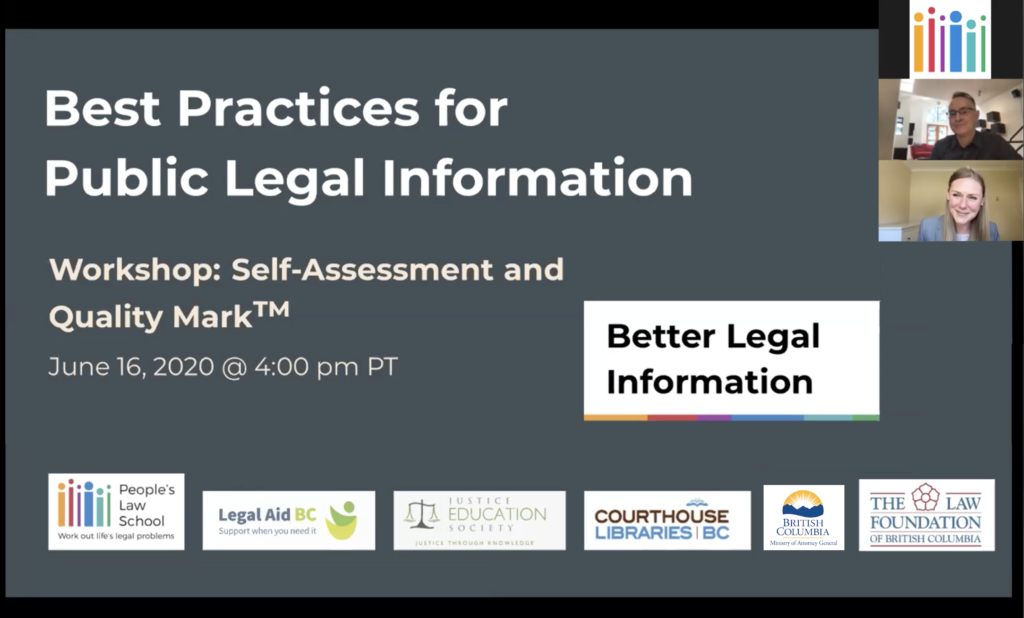Summary: Do you produce legal information for the public in British Columbia? In this webinar, learn strategies to make your information even better. Several non-profits that focus on public legal information teamed up to develop best practices and other tools to help you produce information your audience trusts, understands and uses.
This information applies to British Columbia, Canada
Recorded on: June 16, 2020
Length: 60 minutes
Highlights
In this webinar, you will learn:
- How public legal education is part of the access to justice movement, helping people navigate and access justice. [7:45]
- Why the best practices for public legal information were developed. [9:00]
- How psychologists use the term choice overload to describe the experience of deciding between many options, and how the best practices help people deal with choice overload when looking for legal information. [10:30]
- The underlying purpose of the best practices: to help information providers produce information their audience trusts, understands and uses. [12:25]
- How the best practices were developed, drawing from extensive research and testing with the public, as well as learning from a parallel initiative in Ontario. [14:10]
- What the Quality Mark™ is, and what it signals. [18:40]
- What an information provider needs to do in order to qualify to use the Quality Mark™ on their information. [21:20]
As well, the webinar walks through each of the eight high-impact best practices. You will learn:
- Why saying who made the information (best practice #1) may be the most important of all 16 best practices. [24:15]
- How each of the eight high-impact best practices have indicators — features that show whether information follows the best practice. [27:00]
- How saying where the information applies (best practice #2) is more relevant in the digital age than ever. [29:25]
- The importance of doing a legal review of your information — and telling users you’ve done so (best practice #3). [33:10]
- The importance of information including the date of legal review (best practice #4). [36:35]
- How saying who or what the information is for (best practice #5) helps you reach your intended audience. [39:50]
- The many considerations — like readability levels, visuals, and taking a user perspective — that go into making your information understandable for the intended audience (best practice #6). [41:00]
- How to make your design clean, engaging, and easy to use (best practice #7), using, for example, headings, bolding, and white space. [44:00]
- A key tip in how to refer users to free or low-cost legal help (best practice #8). [45:50]
The webinar also offers highlights of the eight additional best practices. Learn:
- How doing user testing is not as hard as people often think, and can reveal key issues to address with your information. [48:25]
- How using empathy makes it more likely your audience will engage with your information. [49:50]
- Resources to improve accessibility of your information, extending its reach to people of varying abilities. [58:00]
Materials
Attendee feedback
“Thank you for a great webinar. It was engaging and very informative.”
“It’s good to have all the best practices laid out very clearly and with examples.”
“Valuable to learn that providing good PLE isn’t enough — you also have to provide easily digestible cues that information is reliable and useful, or no one will read it.”
“Very competent presenters.”
“Thanks so much for all your work!”
Additional resources
Elsewhere on this website, read the public legal information best practices and take the online self-assessment to see if you qualify to use the Quality Mark™.
The Action Committee on Access to Justice in Civil and Family Matters report, A Roadmap for Change (2013).
Research showing that when faced with more information, people find it harder to decide what information is relevant: Metzger & Flanagin, “Credibility and Trust of Online Information: The Use of Cognitive Heuristics“.
Research showing that cognitive heuristics help people cope effectively with information overload — and they very often lead to accurate decisions: Todd & Gigerenzer, “Simple Heuristics That Make Us Smart“.
Resources to help make information more accessible to people of varying abilities:
- The WC3 Web Accessibility Initiative’s Understanding WCAG 2.1 is a guide to understanding and implementing the Web Content Accessibility Guidelines 2.1.
- Usability.gov’s “Accessibility Basics” highlights key best practices for accessible content.
- Equalweb, an example of an accessibility plugin to make digital content accessible.
Related webinar
Our workshop demo walks through how you can self-assess your information against the public legal information best practices.
